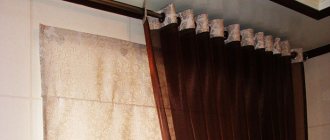Accommodation options
The most suitable location for a self-made hut is a summer cottage. Prolonged exposure of children to fresh air will have a positive effect on their health. There will be enough space for active games on the territory. And the hut itself will be an excellent addition to a summer cottage.
Hut for children in the country
An alternative location would be an apartment if there is enough free space. This option is less convenient, because there is much more space at the dacha. However, a homemade hut in an apartment can stand regardless of the season. And at the dacha only in the warm season.
Children's hut for an apartment
The type of homemade hut will also depend on the location. A structure made from dry branches is much more preferable in a country house rather than in a living room.
General principles of construction
Regardless of the installation location, appearance and variations of a self-made hut for children, several principles should be followed during its creation. The design needs to be as reliable as possible. When installed in a country house, the hut must remain stable even in strong gusts of wind.
A hut for children must be stable and reliable
Manufacturing materials should be made safe. If these are some kind of perches or sticks, then they need to be leveled so that the child cannot get any splinters. By analogy, all resources for the hut should be made safe for children, this is very important.
Before installation, carefully treat the components of the hut
When designing a hut, the main attention should be paid to its safety. The design of the product must be as reliable and stable as possible. And the various elements of the hut should not cause any harm to small children. Contact with wooden parts without splinters and so on.
Make sure the children's hut is stable
How to create an optimal design for a hut house
Due to the steep slope of the roof slopes, the building loses a significant amount of internal space. That is why many developers prefer spacious and low bungalow houses. To reduce these losses to a minimum when selecting the proportions of the structure, it is advisable to choose an option consisting of two triangles of the correct shape. In this case, the shapes will have the following angle sizes: 30°, 90° and 60°.
Essentially, a hut house consists of repeating structures, namely wooden frames that resemble the letter “A”.
If the roof slope angle is 28°, then a person with a height of 1.8-1.9 m will be able to stand at a distance of 1 m from the inclined surface of the wall. The area under the slopes, which is lower than a person’s height, can be divided using vertical partitions and storage rooms or cabinets for storing things can be arranged in this area. If people will live in the house year-round, the walls used for vertical zoning must be insulated.
The space below the height of a person under the inclined walls of the hut can be separated by vertical partitions.
Corrugated sheeting or metal tiles are most often used as roofing materials. These coverings have a smooth surface, so the snow load on the roof is minimal. Precipitation does not linger on the roof, sliding down steep slopes. For this reason, building a hut house with your own hands will be the best option for areas located in mountainous areas or regions with snowy winters.
Note! Do not forget that a high roof creates windage, which is why the building is subject to significant wind loads. When choosing a place for construction, you should definitely take into account the wind rose. It is better to give preference to a reliable base and high-quality strapping of the frame part.
The high roof of a hut house causes a significant wind load on its foundation.
DIY hut variations for children
The structure of the hut itself includes two main elements: the base and the canopy. The first of them sets the general shape. And the second element serves as decoration. However, for dacha variations, the canopy also provides protection from the sun and bad weather.
Children's hut made from scrap materials
When making a hut for children yourself, you can use improvised materials in addition to purchased ones. Dry branches, curtains, tablecloths - all this and many other resources can be used in construction. Thanks to this approach, a hut for children will turn out to be quite affordable in price, as well as beautiful in appearance. Below are several design variations for a summer cottage, as well as an apartment. Huts will also vary in complexity of execution and size of construction.
Hoop hut
One of the simplest options for a children's hut with your own hands will be a design with a hoop. It can be placed both on a summer cottage and in a city apartment. And to create such a hut, available materials are suitable, so the option is quite budget-friendly in price.
DIY hut for children made from hoop
The structure itself consists of a hoop that is located on top and a canopy hanging from it. This variation of a children's hut is very easy to create, install and remove.
Before you start creating, you should prepare materials. A canopy can be easily made from a piece of fabric or curtains. Several different flaps can be used. The height of the hut will be such that a child can fit in it while standing; it is advisable to take the dimensions with a margin. And the canopy itself must touch the ground. Therefore, the material under it should be cut to the required length in advance.
Necessary materials for a children's hut
Making a children's hut from a hoop is extremely simple. First of all, make a mount for hanging on the hoop. Two or four ropes of the same length are suitable for this. They need to be tied to different ends of the hoop, and then connected together. Now the canopy should be attached to it.
Securing ropes for hanging the hut
The material can be secured to the hoop using strong clothespins. A more complicated option would be sewing. The canopy can completely encircle the hoop or leave a small gap in the circle for an entrance. This point is functionally insignificant and is purely decorative.
Cover the hoop with fabric
It is recommended to additionally shield the hoop from light. To do this, it is best to sew a piece of fabric to the edges of the canopy to fit the circumference. After all these steps, the do-it-yourself hut will be finished. All that remains is to hang it in a suitable place.
The hut can be hung in any suitable place
The advantage of such a hut will be its small size; its circumference is limited by a hoop. This design can be installed not only on a summer cottage, but also in a small apartment. And to make a hut you will need a minimum of materials. The general unreliability and simplicity of design is the main disadvantage of this variety.
A hoop hut can also be hung in the room
The hoop hut can be further decorated. Its entire appearance is determined by the canopy. For greater beauty, it can be made from high-quality material. Expensive fabric or tulle works well. You can additionally place an embroidery pattern or something similar on it. A decorated hoop hut will look good, which will be appreciated not only by children, but also by adults.
The simplest hut-tent
On a summer cottage, a hut-tent attached to a rope between the trees will look good. The design is distinguished by its simplicity, ease of erection and disassembly, as well as spaciousness.
Simple hut-tent for children
To build such a hut with your own hands, you will first need a suitable place. The area should be level, with trees on both sides. The resources you will need are a long rope, flooring and a canopy. You can also use many decoration elements for interior and exterior decoration.
First you need to tie a rope between the trees. It will be the basis of the entire structure. The height of the fastening should be slightly higher than the height of the hut. This is due to the fact that the rope will not be fully stretched, but will begin to sag. Now you need to lay the flooring on the ground underneath it. And then throw the canopy over the rope. Secure it with pebbles placed in the corners. Instead, the canopy can be held in place using pegs driven into the ground.
Secure the hut fabric to the ground
Such a homemade hut for children can be made of any size, depending on the free space on the site and the amount of resources. It is also easy to decorate it further. The canopy can be made from a regular blanket, curtains or thick fabric. The material should protect children inside the hut from direct sunlight. Use something soft as flooring.
This type of hut for children can be made in any size
The advantage of a homemade hut-tent is its complete safety for children. If the rope does not support the canopy and the entire structure collapses, then nothing will happen to the child, all the materials are very light. The hut itself is very easy to install and disassemble, it will take a minimum of time. Outwardly, it will look quite unusual, and if the proper materials are used, it will also look beautiful.
The hut-tent is completely safe for children
One of the disadvantages is the instability of the hut-tent to weather conditions. The structure will survive even strong winds without any problems, since it is securely fastened. But a homemade hut will not withstand rain well. The materials used in it do not tolerate water well and quickly get wet. Plus, the structure itself will not be able to completely protect from rain. Therefore, in bad weather, it is best to disassemble it and install it only on sunny days.
The hut-tent is quite easy to modernize. For example, it can be protected from rain. To do this, you need to use waterproof material as a canopy, and also cover two holes with it. This hut can be decorated, for example, by hanging a lantern on a rope for lighting.
Wigwam
A wigwam is a traditional Indian hut. This homemade hut is distinguished by its appearance, design and reliability. This variation is much more difficult to perform; it will require more materials and time to work.
Original wigwam for a summer residence
A self-made “Wigwam” consists of three main elements: a frame, a covering and a flooring. It is most often cone-shaped in shape, with many flat edges. The frame is formed from several sticks, poles or poles of equal length. They are fastened together at a short distance from the ends. As a result, they will rise slightly above the hut itself, forming a smaller cone. The frame itself is covered with dense material. Most often this is some kind of fabric.
Material for wigwam hut
Next there will be instructions for a children's hut “Wigwam” with six sides. This is a more advanced option that will require more materials. However, it is quite simple to make a type of hut for children with your own hands with four sides. The general principle will be the same.
Connect the slats into a single structure
To start, you will need six straight sticks, poles, rods or something similar. It is important that the material is easy to cut and reliable. If it is a wooden pole, then it should be pre-treated. Remove all irregularities from it with sandpaper so that it is completely safe for children.
Now the sticks need to be cut to the same length. It must be selected in such a way that the final height of the hut is significantly higher than the height of the child, and he himself is quite roomy. The pole can also be painted for a more beautiful appearance and varnished to make the material moisture resistant.
Cut the fabric into wide strips
The next step is to prepare the flooring of the children's hut. The final height of the hut will depend on its area, together with the length of the frame sticks. Any soft material is suitable as flooring. The easiest way is to use an old blanket or the remnants of an already unnecessary carpet. The material must first be thoroughly washed and cleaned, and then given the shape of a circle or hexagon. You should also put marks on the flooring for installing poles. They should stand in a circle with an equal indentation so that the structure is reliable and balanced.
Push pins for securing fabric to frame
After this, the sticks need to be installed at the desired points so that they intersect at the top. At the junction they must be connected to each other one by one. Strong rope or thick fabric is best for this. It is advisable to make several knots on each stick. An alternative to this method would be to nail them. It is important to bend the sharp ends and insulate them afterwards. This method is not suitable for already painted and varnished sticks, as the coating will come off as a result.
Now it is important to finally place the poles in the flooring. There are two accommodation options:
On small nails. This is a simpler option.
On the staples of a construction stapler. This option is more reliable.
Secure the fabric to the frame
As a result, the frame must sit securely and be supported by the flooring itself. It can be secured by nailing the poles to adjacent sticks. Do this both from below and in the middle of their length. Then the design will be much more reliable.
The frame is firmly fixed to the flooring and retains its shape. Now you can move on to tightening it. Any scraps of fabric will do for this. The easiest way is to wrap it in several parts. In this case, you will need to prepare five triangular canvases, shaped like the edges of the frame. And the sixth hole will serve as the entrance. Each of them is the same size. You can secure them with small nails or a construction stapler. It is important that the fabric is not completely stretched, but can sag a little. Otherwise it will tear easily.
The process of stretching fabric onto a wigwam frame
The result will be an interesting do-it-yourself hut for children. It can be installed both in an apartment and in a summer cottage. And the covering fabric can be further decorated. Or use several materials to create an ornament on the hut frame.
DIY ready-made hut for children
The main advantage of the Wigwam design will be its reliability. The frame consists of several poles, which are additionally supported by flooring. Plus, this option is distinguished by its capacity.
But such a hut is quite difficult or completely impossible to disassemble. And together with its large dimensions, the design becomes difficult to carry. The Wigwam hut is not mobile, unlike other variations. Another disadvantage is the difficulty of its assembly. For the frame you will need several sticks, pre-processed and adjusted to length. It is also quite difficult to fit, and the price will be more expensive than other varieties.
DIY wigwam for children in the country
The Wigwam hut is one of the most difficult to build. Its design includes many individual elements that must be additionally fastened together. And the amount of materials required to build it is quite high. However, the end result will pleasantly surprise both children and adults. The Wigwam hut turns out to be very reliable and beautiful. And its appearance can be further decorated according to the child’s preferences.
Lean hut
An interesting and fairly simple solution for a summer cottage would be to build a lean-to hut for children with your own hands. Its design is distinguished by its simplicity, speed of construction and small amount of required material. Such a hut will be shaped like a canvas located at an angle.
Construction of a lean-to hut
The basis of the structure will be two stands on which the support stick will be placed. One of them can be a low tree branch, and then a pole of the same length can be used as the second. A stretched sheet of tarpaulin or other water-repellent material will serve as the roof of the hut.
Putting the structure together is extremely simple. The roofing material should be secured to two long sticks on both sides. Nails or strong rope are suitable for this. The canvas must be held firmly on the poles so that it does not get torn off by a gust of wind.
Now you can begin installing the base for the hut. It will require two supports or one, but with a tree branch. It is best to make them from two strong and long sticks. They should first be trimmed and cut to equal length. It is worth considering that the sticks will be fixed in the ground. After installation, one of the support poles with a canvas should be attached to them.
It is important to place the base in such a way that the roof protects visitors to the hut from direct sunlight and wind. The height of the stick is best to make it a meter above the ground. The lower part of the canvas with the second support pole should be nailed to the ground. To do this, just put something heavy on top. For example, stones at both corners of the canvas or a massive log.
Now the lean-to hut is ready. Its advantages include ease of assembly and disassembly, as well as the ability to move the structure. The hut is rain resistant. This is due to the fact that its roof is made of water-repellent material. And the remaining parts can be additionally treated with a special varnish.
However, the design of such a hut provides only one roof slope. Due to this, on other sides it is vulnerable to wind and rain. A lean-to hut will not provide complete shelter from bad weather. But it will easily protect from light rain or light wind from the roof.
All the variations of homemade huts for children presented above are solely the basis for future designs. That is, during the creation process they can be further modernized and also decorated. The final appearance of the building will depend solely on the wishes of its author. The appearance of the hut can be chosen in such a way that it is most pleasant for the child. The result will be a unique design for a house or summer cottage. When constructing, it is important not to forget about the requirements of safety and reliability.
Hut house and beneficial advantages of such projects
The popularity of huts is due to a large number of advantages. Such buildings are characterized by a simple installation system. Construction does not require the help of specialists, since the owner of the land plot can assemble the structure of a modular house with his own hands. You will have to tinker with the frame structure a little longer, but it will not cause serious problems.
An important advantage of a hut house is the space saving, thanks to the triangular type of construction, which, moreover, will not block the sun from the plants.
The building has no walls, so its construction will take less time. There is no need for masonry work or pouring formwork structures. The ease of installation also explains the low price of buildings in the form of a hut. The estimate does not include the costs of performing masonry work, as well as purchasing mortar for them. In addition, the design does not require a heavy and massive foundation, so construction costs are significantly reduced.
The relative simplicity of constructing the structure and the high pace of construction, due to the absence of walls, are important advantages of the hut house.
Triangular-shaped buildings allow you to save free space on small plots of land. On the Internet you can find many ready-made house designs on 6 acres with compact dimensions, which are ideal for temporary residence in the country. Due to their configuration, structures in the form of a hut provide a minimum of shade, which is an advantage if light-loving plants are grown on the site.
A gable roof reaching right down to the foundation or plinth is the most suitable option for regions with a humid climate.
A house made from natural materials will fit perfectly into any landscape, be it a hut in the forest or a triangular building in the countryside. The design will look equally good in an open space, next to other buildings or surrounded by tall trees and mountains.
The original appearance of the hut-type house is in perfect harmony with the countryside.
A roof with two slopes will be the best option if the construction of a house is carried out in an area with humid climatic conditions, where there is prolonged rain in the fall and heavy snowfall in winter. Thanks to its low placement, the roof protects the foundation and other areas of the building from getting wet and collapsing.











